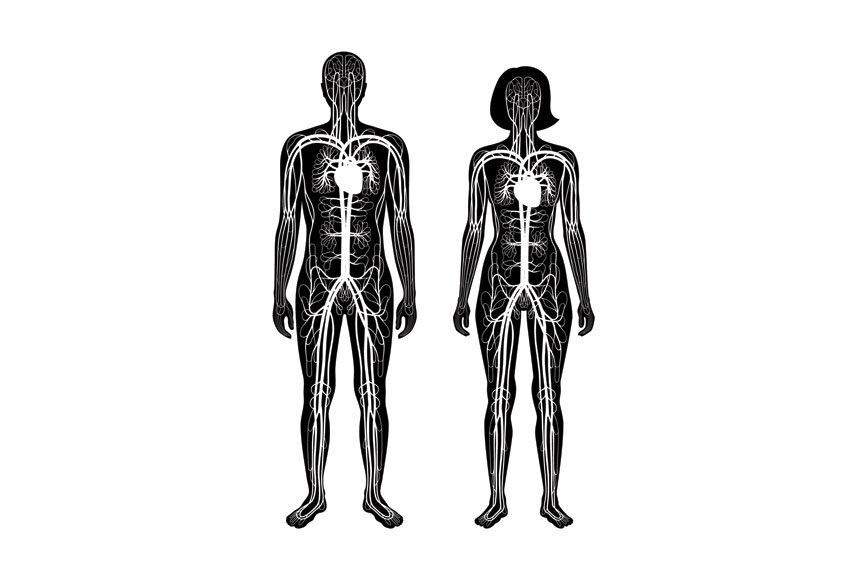Senior managing editor and logophile Andy Hollandbeck reveals the sometimes surprising roots of common English words and phrases. Remember: Etymology tells us where a word comes from, but not what it means today.
From the crown of your head to the tips of the phalanges on your feet (that’s your toe bones), your body contains a lot of individual and intricate parts, and all those parts have names. (Some have more than one.) Here are eight of the odder anatomical names and where they (the names, not the body parts) came from:
Dewlap
Originally used to describe a feature more common on animals, a dewlap is loose flesh that hangs down from the neck or throat. Dewlaps are more common and prominent on humans as we age.
Where the dew part of the word comes from is a mystery and has probably been altered through folk etymology. The lap part of the word, though, comes from the Old English lappe, meaning “loose piece.” Dewlap, then, is an etymological cousin of lap, which was used to describe a skirt or flap of a garment, then the lower front part of a shirt or skirt, and then the front of the legs, which were covered by that cloth lap.
The dewlap is also called the wattle.
Glabella
Your glabella is the space between your eyebrows. This word was concocted in the late 16th century from the adjective glabellus, which is a diminutive form of glaber, Latin for “smooth, bald.” A glabella, then, is “a little bald space” above your nose. (Presumably, someone with a unibrow doesn’t technically have a glabella.)
Lunula
If you notice luna, the Latin word for “moon,” in lunula, you’re on the right track. Though it can be used to describe any crescent-shaped body part, it most often refers to the white arcs at the base of one’s fingernails.
Omphalos
Omphalos was originally the Greek word for “belly button,” and occasionally it’s still used in that respect today. The Greeks later also used the word as a name for the stone at the shrine of Delphi that was thought to be the center of the universe. Centrality is a main ingredient in the use of omphalos, which can also be a high falutin’ way to refer to a hub.
If you add on a form of the Greek word skopein “to look” (which, after passing through Latin, also gave us the second half of microscope and telescope), you end up with omphaloskepsis — a fancy word that means “navel-gazing.”
Oxter
Used primarily in Scotland and Ireland, oxter is another word for an armpit. It’s an alteration of the Old English oxta, which is related to axis, “a line about which a rotating body turns,” which, if you think about it, seems like a better name for a shoulder. But what is an armpit if not the bottom of a shoulder?
Philtrum
Philtrum appears on every online list of “body part names you didn’t know existed,” so if you’re a word lover at all, you probably already know that the philtrum is the indentation between your nose and your mouth. What you might not know is that the word has been around since 1703, and it comes from a Latinized version of the Greek word philtron, meaning “love charm.” Presumably it has something to do with the philtrum’s involvement in kissing.
Supercilium
This is straight-up Latin from the mid-17th century. Cilium, probably related to celare “to cover,” is Latin for “eyelid.” Super (from supra) means “over, above.” So supercilia (the plural) is that which is above your eyelids, namely your eyebrows, those thin lines of fine hair on either side of your glabella.
You might be more familiar with an adjective form of the word, supercilious. The raising of an eyebrow has long been an indication of haughtiness or contempt for something thought to be beneath you. Which is why as far back as the early 16th century in English (and even earlier in Latin), supercilious has described such an arrogant or contemptuous expression.
Modern doctors, when they need to refer to something in relation to the eyebrows, are more likely to use the form superciliary; such is the plasticity of the English language.
Tragus
The tragus is the little nub at the front of your outer ear that hovers over the ear canal, and its name comes from an unexpected source: Peloponnesian drama. According to tradition (or hearsay, depending on your angle), in such performances, satyrs were depicted as goat-like creatures, with big goaty ears. Those ears became associated with the smaller feature on the human ear. In Greek, the word for a male goat is tragos, so the protuberance on the ear became, by the 17th century, the tragus.
The bit of cartilage on the outer ear that is directly across from the tragus (if you’re touching your tragus right now, move your finger straight down) is called the antitragus.
Incidentally, tragos is also the root of the word tragedy.
Become a Saturday Evening Post member and enjoy unlimited access. Subscribe now




Comments
Wow. I did not know any of this, regarding the human body. It’s still a nuisance to maintain, but worth it.